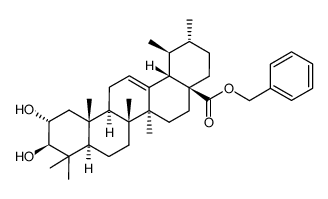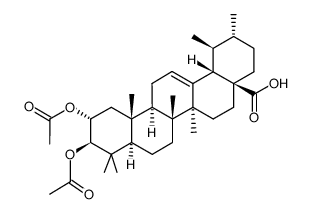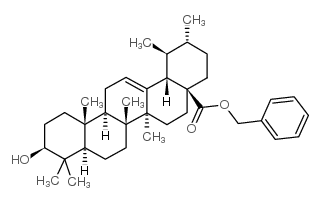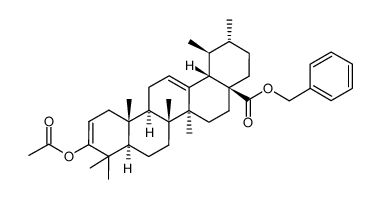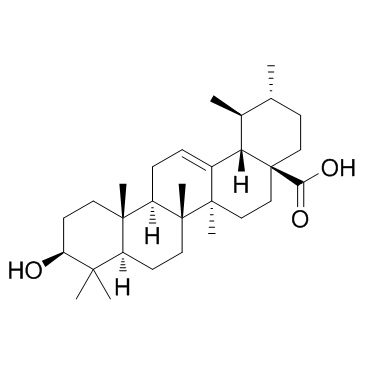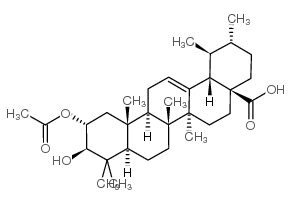Corosolic acid
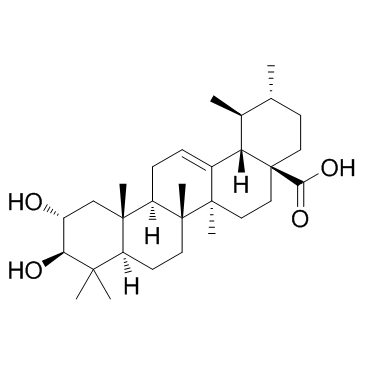
Corosolic acid structure
|
Common Name | Corosolic acid | ||
|---|---|---|---|---|
| CAS Number | 4547-24-4 | Molecular Weight | 472.700 | |
| Density | 1.1±0.1 g/cm3 | Boiling Point | 573.3±50.0 °C at 760 mmHg | |
| Molecular Formula | C30H48O4 | Melting Point | N/A | |
| MSDS | USA | Flash Point | 314.6±26.6 °C | |
Use of Corosolic acidCorosolic acid isolated from the fruit of Cratoegus pinnatifida var. psilosa, was reported to have anticancer activity.IC50 value: 26.8 μg/ml in vitroTarget:In vitro: Corosolic acid displayed about the same potent cytotoxic activity as ursolic acid against several human cancer cell lines. In addition, the compound displayed antagonistic activity against the phorbol ester-induced morphological modification of K-562 leukemic cells, indicating the suppression of protein kinase C (PKC) activity by the cytotoxic compound. The compound showed PKC inhibition with dose-dependent pattern in an in vitro PKC assay [1]. MTT method was used to detect the influence of corosolic acid on A549 lung cancer cell growth in vitro under different concentrations. The value of IC50 was 26.8 μg/ml in vitro experiment. Corosolic acid of different doses had certain therapeutic effects on A549 solid tumor, the content of VEGF and CD34 proteins also had different degrees of influence [2]. Corosolic acid induced apoptosis in CT-26 cells, mediated by the activation of caspase-3. It inhibited the proliferation and tube formation of human umbilical vein endothelial cells and human dermal lymphatic microvascular endothelial cells, decreased the proliferation and migration of human umbilical vein endothelial cells stimulated by angiopoietin-1 [3]. In vivo: A mouse colon carcinoma CT-26 animal model was employed to determine the in vivo anti-angiogenic and anti-lymphangiogenic effects of corosolic acid. |
| Name | Corosolic acid |
|---|---|
| Synonym | More Synonyms |
| Description | Corosolic acid isolated from the fruit of Cratoegus pinnatifida var. psilosa, was reported to have anticancer activity.IC50 value: 26.8 μg/ml in vitroTarget:In vitro: Corosolic acid displayed about the same potent cytotoxic activity as ursolic acid against several human cancer cell lines. In addition, the compound displayed antagonistic activity against the phorbol ester-induced morphological modification of K-562 leukemic cells, indicating the suppression of protein kinase C (PKC) activity by the cytotoxic compound. The compound showed PKC inhibition with dose-dependent pattern in an in vitro PKC assay [1]. MTT method was used to detect the influence of corosolic acid on A549 lung cancer cell growth in vitro under different concentrations. The value of IC50 was 26.8 μg/ml in vitro experiment. Corosolic acid of different doses had certain therapeutic effects on A549 solid tumor, the content of VEGF and CD34 proteins also had different degrees of influence [2]. Corosolic acid induced apoptosis in CT-26 cells, mediated by the activation of caspase-3. It inhibited the proliferation and tube formation of human umbilical vein endothelial cells and human dermal lymphatic microvascular endothelial cells, decreased the proliferation and migration of human umbilical vein endothelial cells stimulated by angiopoietin-1 [3]. In vivo: A mouse colon carcinoma CT-26 animal model was employed to determine the in vivo anti-angiogenic and anti-lymphangiogenic effects of corosolic acid. |
|---|---|
| Related Catalog | |
| References |
| Density | 1.1±0.1 g/cm3 |
|---|---|
| Boiling Point | 573.3±50.0 °C at 760 mmHg |
| Molecular Formula | C30H48O4 |
| Molecular Weight | 472.700 |
| Flash Point | 314.6±26.6 °C |
| Exact Mass | 472.355255 |
| PSA | 77.76000 |
| LogP | 7.82 |
| Vapour Pressure | 0.0±3.6 mmHg at 25°C |
| Index of Refraction | 1.567 |
| InChIKey | HFGSQOYIOKBQOW-ZSDYHTTISA-N |
| SMILES | CC1CCC2(C(=O)O)CCC3(C)C(=CCC4C5(C)CC(O)C(O)C(C)(C)C5CCC43C)C2C1C |
| Storage condition | 2-8°C |
|
SECTION 1: Identification of the substance/mixture and of the company/undertaking Product identifiers Product name: Corosolic acid REACH No.: A registration number is not available for this substance as the substance or its uses are exempted from registration, the annual tonnage does not require a registration or the registration is envisaged for a later registration deadline.
CAS-No.: 4547-24-4 Relevant identified uses of the substance or mixture and uses advised against Identified uses: Laboratory chemicals, Manufacture of substances SECTION 2: Hazards identification Classification of the substance or mixture Not a hazardous substance or mixture according to Regulation (EC) No. 1272/2008. This substance is not classified as dangerous according to Directive 67/548/EEC. Label elements The product does not need to be labelled in accordance with EC directives or respective national laws. Other hazards - none SECTION 3: Composition/information on ingredients Substances Formula: C30H48O4 Molecular Weight: 472,70 g/mol CAS-No.: 4547-24-4 No components need to be disclosed according to the applicable regulations. SECTION 4: First aid measures Description of first aid measures If inhaled If breathed in, move person into fresh air. If not breathing, give artificial respiration. In case of skin contact Wash off with soap and plenty of water. In case of eye contact Flush eyes with water as a precaution. If swallowed Never give anything by mouth to an unconscious person. Rinse mouth with water. Most important symptoms and effects, both acute and delayed The most important known symptoms and effects are described in the labelling (see section 2.2) and/or in section 11 Indication of any immediate medical attention and special treatment needed no data available SECTION 5: Firefighting measures Extinguishing media Suitable extinguishing media Use water spray, alcohol-resistant foam, dry chemical or carbon dioxide. Special hazards arising from the substance or mixture Carbon oxides Advice for firefighters Wear self contained breathing apparatus for fire fighting if necessary. Further information no data available SECTION 6: Accidental release measures Personal precautions, protective equipment and emergency procedures Avoid dust formation. Avoid breathing vapours, mist or gas. For personal protection see section 8. Environmental precautions Do not let product enter drains. Methods and materials for containment and cleaning up Sweep up and shovel. Keep in suitable, closed containers for disposal. Reference to other sections For disposal see section 13. SECTION 7: Handling and storage Precautions for safe handling Provide appropriate exhaust ventilation at places where dust is formed. For precautions see section 2.2. Conditions for safe storage, including any incompatibilities Store in cool place. Keep container tightly closed in a dry and well-ventilated place. Specific end use(s) Apart from the uses mentioned in section 1.2 no other specific uses are stipulated SECTION 8: Exposure controls/personal protection Control parameters Components with workplace control parameters Exposure controls Appropriate engineering controls General industrial hygiene practice. Personal protective equipment Eye/face protection Use equipment for eye protection tested and approved under appropriate government standards such as NIOSH (US) or EN 166(EU). Skin protection Handle with gloves. Gloves must be inspected prior to use. Use proper glove removal technique (without touching glove's outer surface) to avoid skin contact with this product. Dispose of contaminated gloves after use in accordance with applicable laws and good laboratory practices. Wash and dry hands. The selected protective gloves have to satisfy the specifications of EU Directive 89/686/EEC and the standard EN 374 derived from it. Body Protection Choose body protection in relation to its type, to the concentration and amount of dangerous substances, and to the specific work-place., The type of protective equipment must be selected according to the concentration and amount of the dangerous substance at the specific workplace. Respiratory protection Respiratory protection is not required. Where protection from nuisance levels of dusts are desired, use type N95 (US) or type P1 (EN 143) dust masks. Use respirators and components tested and approved under appropriate government standards such as NIOSH (US) or CEN (EU). Control of environmental exposure Do not let product enter drains. SECTION 9: Physical and chemical properties Information on basic physical and chemical properties a) AppearanceForm: powder Colour: white b) Odourno data available c) Odour Thresholdno data available d) pHno data available e) Melting point/freezingMelting point/range: 243 - 245 °C point f) Initial boiling point and no data available boiling range g) Flash pointno data available h) Evapouration rateno data available i) Flammability (solid, gas) no data available j) Upper/lowerno data available flammability or explosive limits k) Vapour pressureno data available l) Vapour densityno data available m) Relative densityno data available n) Water solubilityno data available o) Partition coefficient: n- no data available octanol/water p) Auto-ignitionno data available temperature q) Decompositionno data available temperature r) Viscosityno data available s) Explosive propertiesno data available t) Oxidizing propertiesno data available Other safety information no data available SECTION 10: Stability and reactivity Reactivity no data available Chemical stability Stable under recommended storage conditions. Possibility of hazardous reactions no data available Conditions to avoid no data available Incompatible materials Strong oxidizing agents Hazardous decomposition products In the event of fire: see section 5 SECTION 11: Toxicological information Information on toxicological effects Acute toxicity no data available Skin corrosion/irritation no data available Serious eye damage/eye irritation no data available Respiratory or skin sensitisation no data available Germ cell mutagenicity no data available Carcinogenicity IARC:No component of this product present at levels greater than or equal to 0.1% is identified as probable, possible or confirmed human carcinogen by IARC. Reproductive toxicity no data available Specific target organ toxicity - single exposure no data available Specific target organ toxicity - repeated exposure no data available Aspiration hazard no data available Additional Information RTECS: Not available change in serum glucose level SECTION 12: Ecological information Toxicity no data available Persistence and degradability no data available Bioaccumulative potential no data available Mobility in soil no data available Results of PBT and vPvB assessment PBT/vPvB assessment not available as chemical safety assessment not required/not conducted Other adverse effects no data available SECTION 13: Disposal considerations Waste treatment methods Product Offer surplus and non-recyclable solutions to a licensed disposal company. Contaminated packaging Dispose of as unused product. SECTION 14: Transport information UN number ADR/RID: -IMDG: -IATA: - UN proper shipping name ADR/RID: Not dangerous goods IMDG: Not dangerous goods IATA:Not dangerous goods Transport hazard class(es) ADR/RID: -IMDG: -IATA: - Packaging group ADR/RID: -IMDG: -IATA: - Environmental hazards ADR/RID: noIMDG Marine pollutant: noIATA: no Special precautions for user no data available SECTION 15 - REGULATORY INFORMATION N/A SECTION 16 - ADDITIONAL INFORMATION N/A |
| RIDADR | NONH for all modes of transport |
|---|
|
~98% 
Corosolic acid CAS#:4547-24-4 |
| Literature: Wen, Xiaoan; Sun, Hongbin; Liu, Jun; Cheng, Keguang; Zhang, Pu; Zhang, Liying; Hao, Jia; Zhang, Luyong; Ni, Peizhou; Zographos, Spyros E.; Leonidas, Demettes D.; Alexacou, Kyra-Melinda; Gimisis, Thanasis; Hayes, Joseph M.; Oikonomakos, Nikos G. Journal of Medicinal Chemistry, 2008 , vol. 51, # 12 p. 3540 - 3554 |
|
~% 
Corosolic acid CAS#:4547-24-4 |
| Literature: Use- Techno Corporation Patent: US2005/137259 A1, 2005 ; Location in patent: Page/Page column 5 ; |
|
~% 
Corosolic acid CAS#:4547-24-4 |
| Literature: Wen, Xiaoan; Sun, Hongbin; Liu, Jun; Wu, Guanzhong; Zhang, Luyong; Wu, Xiaoming; Ni, Peizhou Bioorganic and Medicinal Chemistry Letters, 2005 , vol. 15, # 22 p. 4944 - 4948 |
|
~% 
Corosolic acid CAS#:4547-24-4 |
| Literature: Wen, Xiaoan; Sun, Hongbin; Liu, Jun; Wu, Guanzhong; Zhang, Luyong; Wu, Xiaoming; Ni, Peizhou Bioorganic and Medicinal Chemistry Letters, 2005 , vol. 15, # 22 p. 4944 - 4948 |
|
~% 
Corosolic acid CAS#:4547-24-4 |
| Literature: Wen, Xiaoan; Sun, Hongbin; Liu, Jun; Wu, Guanzhong; Zhang, Luyong; Wu, Xiaoming; Ni, Peizhou Bioorganic and Medicinal Chemistry Letters, 2005 , vol. 15, # 22 p. 4944 - 4948 |
|
~% 
Corosolic acid CAS#:4547-24-4 |
| Literature: Wen, Xiaoan; Sun, Hongbin; Liu, Jun; Wu, Guanzhong; Zhang, Luyong; Wu, Xiaoming; Ni, Peizhou Bioorganic and Medicinal Chemistry Letters, 2005 , vol. 15, # 22 p. 4944 - 4948 |
|
~% 
Corosolic acid CAS#:4547-24-4 |
| Literature: Das, Manik C.; Mahato, Shashi B. Phytochemistry (Elsevier), 1982 , vol. 21, # 8 p. 2069 - 2074 |
|
~% 
Corosolic acid CAS#:4547-24-4 |
| Literature: Talapatra, Bani; Chaudhuri, Prabir K.; Mallik, Asok K.; Talapatra, Sunil K. Phytochemistry (Elsevier), 1983 , vol. 22, # 11 p. 2559 - 2562 |
|
~% 
Corosolic acid CAS#:4547-24-4 |
|
Literature: Glen,A.T. et al. Journal of the Chemical Society [Section] C: Organic, 1967 , vol. |
| Precursor 8 | |
|---|---|
| DownStream 1 | |
|
Nanoparticles Containing Curcumin Useful for Suppressing Macrophages In Vivo in Mice.
PLoS ONE 10 , e0137207, (2015) To explore a novel method using liposomes to suppress macrophages, we screened food constituents through cell culture assays. Curcumin was one of the strongest compounds exhibiting suppressive effects... |
|
|
Simultaneous determination of five triterpene acids in rat plasma by liquid chromatography-mass spectrometry and its application in pharmacokinetic study after oral administration of Folium Eriobotryae effective fraction.
Biomed. Chromatogr. 29 , 1791-7, (2015) Folium Eriobotryae effective fraction (FEA), the extract of Folium Eriobotryae, had been used as anti-hyperglycemia and anti-hyperlipemia medicine in China. A previous study indicated that euscaphic a... |
|
|
Corosolic Acid Inhibits Hepatocellular Carcinoma Cell Migration by Targeting the VEGFR2/Src/FAK Pathway.
PLoS ONE 10 , e0126725, (2015) Inhibition of VEGFR2 activity has been proposed as an important strategy for the clinical treatment of hepatocellular carcinoma (HCC). In this study, we identified corosolic acid (CA), which exists in... |
| 2-a-hydroxyursolic acid |
| hydroxyursolic acid |
| Corosolic acid |
| Urs-12-en-28-oic acid, 2,3-dihydroxy-, (2α,3β)- |
| 2,3-dihydroxyurs-12-en-28-oic acid |
| 2alpha-hydroxyursolic acid |
| 2α-Hydroxyursolic acid |
| MFCD03840521 |
| (2α,3β)-2,3-Dihydroxyurs-12-en-28-oic acid |
